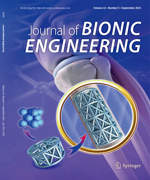Nature has always inspired human achievements in industry, and biomimetics is increasingly being applied in fluid power technology. Arachnida use hydraulic forces, rather than muscle, for leg extensions during locomotion. Many cold-blooded and soft-bodied organisms rely on a hydrostatic skeleton to transmit force, which involves a hydraulic mechanism. Biological hydraulic transmission differs from engineering hydraulic transmission in many aspects, such as in energy transfer and transformation, the movement mode, environmental friendliness, system pressure level, and energy supplement mode. The existence of a hydraulic mechanism in a biological drive requires 3 features: a power source, cavity, and working medium. The power source is similar to a hydraulic pump, and the cavity is similar to a hydraulic cylinder, both of which are necessary for producing deformation. The working medium is similar to a hydraulic fluid. Under these 3 conditions, a biological flow is generated inside or outside the body to meet the requirements of a biological drive. This paper reviews the biological organisms that employ hydraulic systems, identifies related studies on these biological hydraulic systems, and summarizes the mechanisms involved in using hydraulic pressure to achieve graceful and agile movements. This in-depth study and exploration of biological hydraulic systems can provide a good reference for solving the challenges of using hydraulic systems, such as increasing the energy efficiency, improving reliability, building smart components and systems, reducing the size and weight of compo-nents, reducing the environmental impact of systems, and improving and applying energy storage and redeployment capabilities. This paper also includes a detailed discussion of new ideas and innovative sources for the future development of hydraulic systems. In contrast with the bio-inspired designs used in other engineering fields, very few studies have reported on using bio-inspired methods for hydraulic transmission techniques. The aim of this work is to attract the attention of researchers to help address this gap and to promote the use of biologically-inspired methods to improve engineering fluid power systems.

 Table of Content
Table of Content
 Table of Content
Table of Content